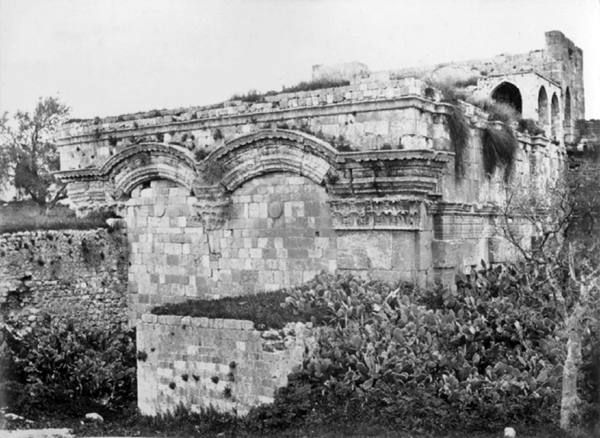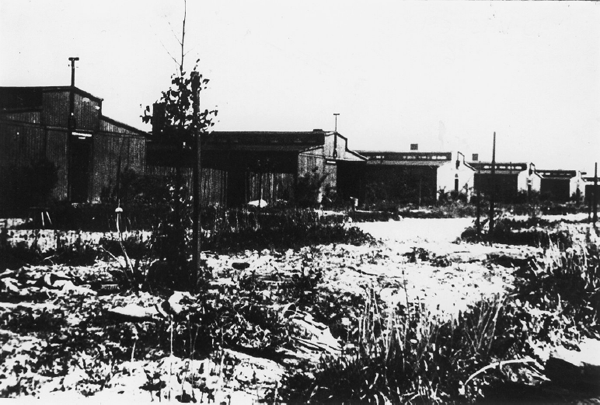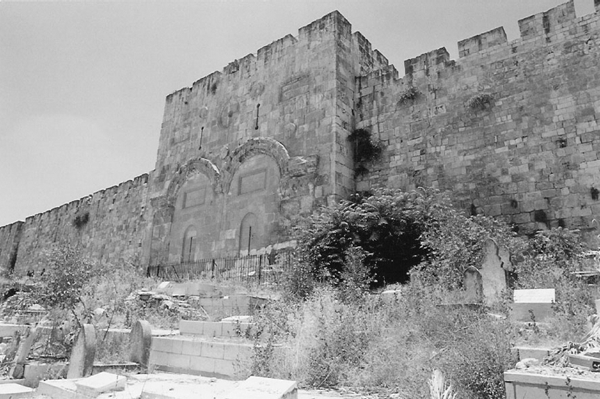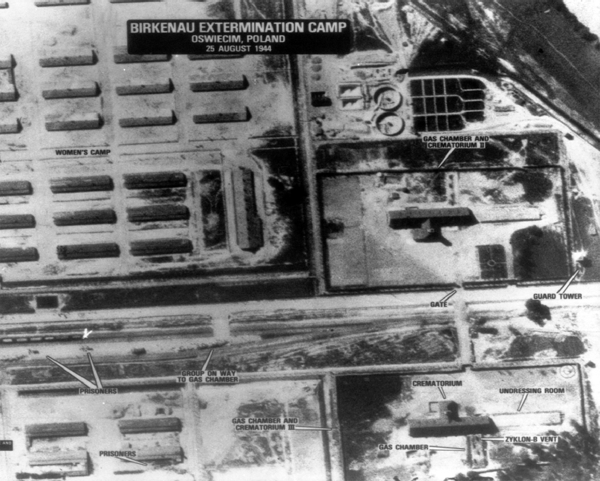
Landscapes of a Private Mythology
At the Sealed Gate of Mercy
In this chapter I move to a very different time, to Jerusalem of the late 1960s. I do not remember if it was immediately after the war – the Six Day War – or some time later, after I returned from a year in England, but the place where I underwent this experience was the Temple Mount. It was my first visit to the Temple Mount, or at least to its desolate and neglected north-eastern part, past the Dome of the Rock on the way to the Gate of Mercy, the sealed Golden Gate.1

36.
I went alone. I crossed the tiled plaza, passed by the ancient magnificence which had survived. I continued to the untended, desolate area, which was entirely overgrown with grass and high thorns – not so high, but dense, dark, grey – and an overwhelming quiet accompanied me as I approached the descent to the blocked gate.
Suddenly I was struck by a feeling of absolute certainty, not to be questioned: in this place I have been before!
That was absurd, of course. Of course I had not been to this place, not ever, could not have been, but the certainty was total, unmistakable. I wrack my brain, try to analyse things, identify details, probe feelings, find explanations – and at that moment I stopped. Stopped next to rusting barbed wire that had been thrown into the grass which grew wildly there. The identification seems very simple, though one could ask: ‘What is the connection between barbed wire here and Auschwitz?’ It was clear to me that this was not Auschwitz of its ‘period of glory and grandeur’, but Auschwitz of that first dim visit from the years after the war, which had apparently sunk completely into my memory and which I have not mentioned until now. The visit of a fourteen-year-old boy, in order to appear as a witness in a trial held in Kraków in 1946 against Auschwitz criminals. While there, we were permitted to visit Auschwitz itself, and we also reached Birkenau.

37.
The primal experience of those desolate ruins, of that terrible contrast, of a place charged with historic meaning, an event on a colossal scale, dramatic, teeming with people, death, history; the consciousness of such highly charged meaning now apparelled as a ruin, and the contrast between this and the sense one had then of vast events unfolding being so grating yet so pertinent – here, apparently, lay the root cause of the amazement which struck the tourist walking on the Temple Mount and cut through the layers sealed by the passage of time.
Indeed, that place was charged like no other with the unfolding of a historical trauma, with death and end-time, with everything that came out of it or flowed into it, and walking across it was to make one’s way through the mute ruins, through grass growing wild, amid the rusting barbed wire that links this place to that. Had it not been for that barbed wire, there might never have arisen that stunning and unmistakable feeling: in this place I have been before!
When I understood this I returned to Auschwitz. Not immediately. I left the Temple Mount, physically, but in my consciousness returned to Auschwitz. It must have been then that I arrived at the decision to return there and wander through that desolation, amid the polarity in which of course I always feel the heaving presence of life and death there, the machinery of that fearful history which is no more. This is what always draws me back to that fearful immutable law which seizes me and does not release me and whose essence has, for me, remained there. It was apparently then that I decided, perhaps without being aware of it, to return. That is the background for what happened ten years later, in the journey to Poland in 1978, when I took part in a scientific conference whose end was the return journey to the Metropolis of Death – as perhaps it still is today. I do not think I will go back to that place again, but that visit, which I made alone, probably had its genesis in my astonishing experience then, on the desolate and neglected Temple Mount, opposite the sealed Gate of Mercy.2

38.
The Blue Skies of Summer
Another leap in time, to a different landscape and different colours. The colour is blue: clear blue skies of summer. Silver-coloured toy aeroplanes carrying greetings from distant worlds pass slowly across the azure skies while around them explode what look like white bubbles. The aeroplanes pass by and the skies remain blue and lovely, and far off, far off on that clear summer day, distant blue hills as though not of this world make their presence felt. That was the Auschwitz of that eleven-year-old boy. And when this boy, the one who is now recording this, asks himself – and he asks himself many times – what the most beautiful experience in your childhood landscapes was, where you escape to in pursuit of the beauty and the innocence of your childhood landscapes, the answer is: to those blue skies and silver aeroplanes, those toys, and the quiet and tranquillity that seemed to exist all around; because I took in nothing but that beauty and those colours, and so they have remained imprinted in my memory.
This contrast is an integral element of the black columns that are swallowed up in the crematoria, the barbed-wire fences that are stretched tight all around by the concrete pillars. But in that experience all this seemingly did not exist, only in the background and not consciously.

39.
Consciousness has internalized and submerged the sensation of the bold summer colours of that immense space; of the cerulean skies, the aeroplanes – and of the boy gazing at them and forgetting everything around him. There is almost no return to that Metropolis, with its sombre colours, with the sense of the immutable law that encloses all its beings within confines of allotted time and of death; that is, there is almost no sense of a return to that world without a sense of return to those wonderful colours, to that tranquil, magical and beckoning experience of those blue skies of the summer of 1944 in Auschwitz-Birkenau.
I can search for a great many similar experiences, perhaps from before Auschwitz was, from before the expulsion was, in my earlier childhood: landscapes of childhood in Bohemia, green and bright – but they all pale. So too with later landscapes in Israel, landscapes in fiery colours under a blazing light of yellow and blue – the blue of the sky in this land is many times stronger than any blue one can see anywhere else, or that I have seen elsewhere. But even so, the one is pale and blurred, the other strong and harsh and somehow does not belong. The only belonging blue, overcoming every other colour, imprinted in my memory as the colour of summer, the colour of tranquillity, the colour of forgetting – momentary forgetting – is that colour of a Polish summer in 1944. And for that little boy who is part of that summer, all this will remain for all time as a touchstone of beauty, nonpareil in all the landscapes I have collected into myself and which I will probably be able to collect – how to put it, in a phrase – for all time. I do not know how much longer I have until that ‘for all time’, but I have absolutely no doubt that to here I will always return. This return, even if it is divorced from that sombre return from which there is no way out, is itself a return which has no way out. The colour is the colour of childhood, a colour of innocence, a colour of beauty. And this too is an immutable law from which there is no escape. There is no escape from beauty, from the sense of beauty at the height and in the midst of the Great Death which governs all.